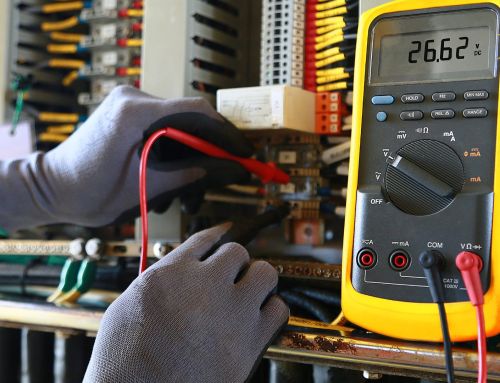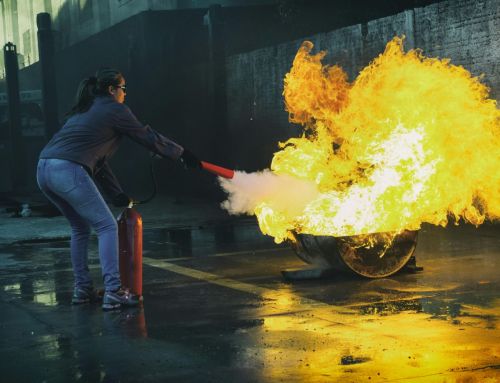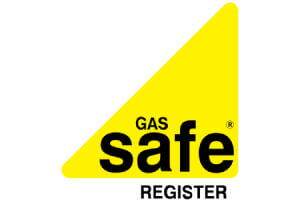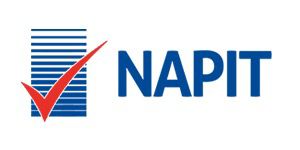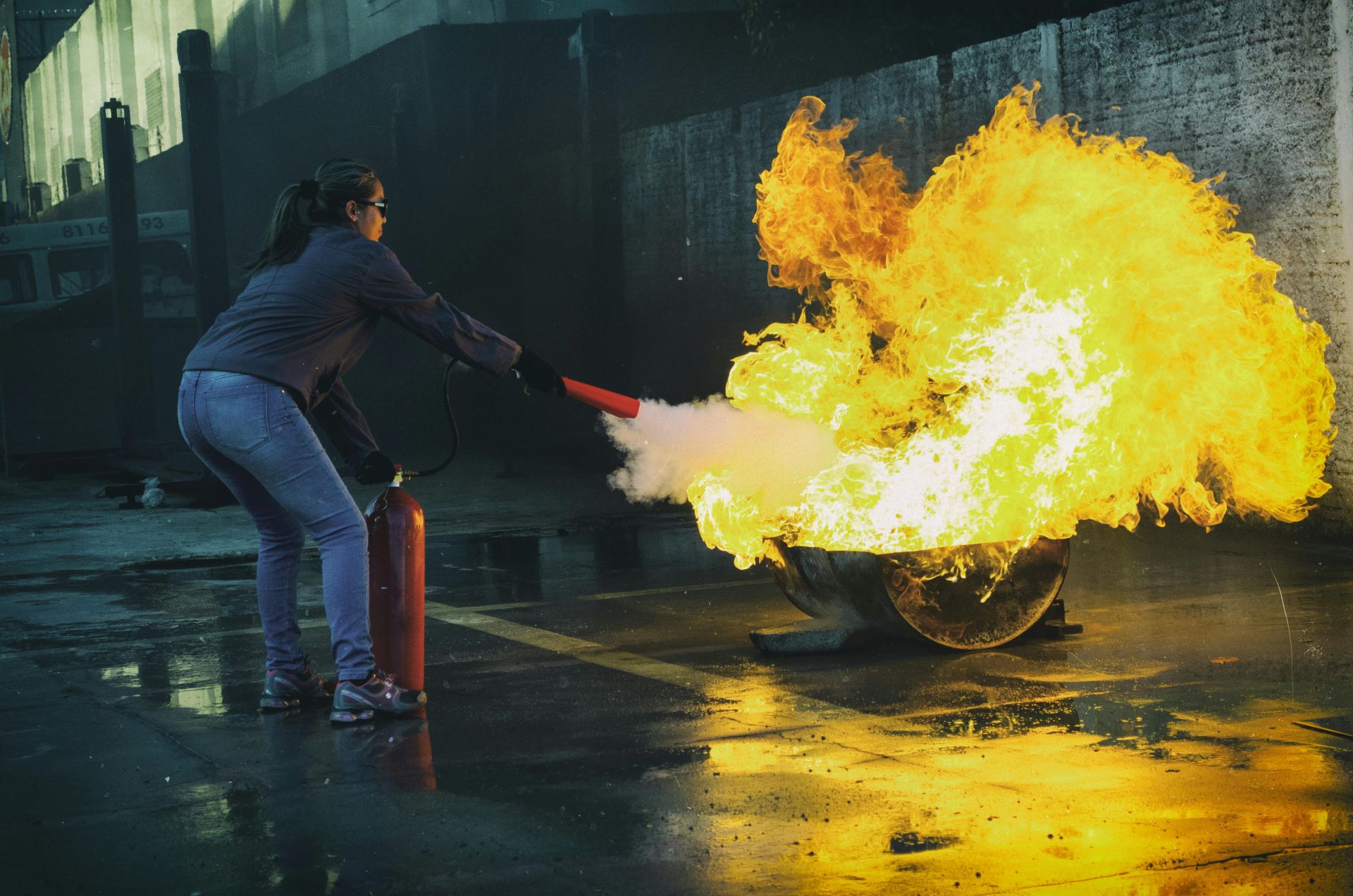
In the realm of emergency preparedness, fire safety is paramount, yet often overlooked until it’s too late. Our discussion today focuses on ten pivotal fire safety measures that can significantly mitigate the risk of fire-related incidents in both residential and commercial settings. These guidelines range from the installation of smoke alarms to the proper handling and knowledge of fire extinguishers.
By implementing these strategies, one not only enhances their immediate safety but also contributes to a broader culture of prevention and awareness. Understanding these tips could be the key to safeguarding your environment, but how well do they integrate into our daily lives and existing safety protocols? Let’s explore the practical implications and the challenges they might pose. Discover 10 Fire Safety Tips.
Key Takeaways
- Install and regularly test smoke alarms on every level of your home.
- Develop and practice a fire escape plan with two exits per room.
- Store flammable materials in designated containers away from heat sources.
- Never leave cooking unattended and keep kitchen surfaces free of grease.
- Regularly inspect and maintain heating systems to prevent overheating.
Fire Safety Tips Overview
Fire safety tips are essential guidelines designed to create a secure environment in both workplace and residential settings. These practices are pivotal for office managers, workers, and homeowners alike, emphasizing the importance of proactive prevention measures to safeguard against potential fire hazards.
Mastery of these guidelines ensures not only the protection of lives but also the preservation of property and continuity of operations in business settings.
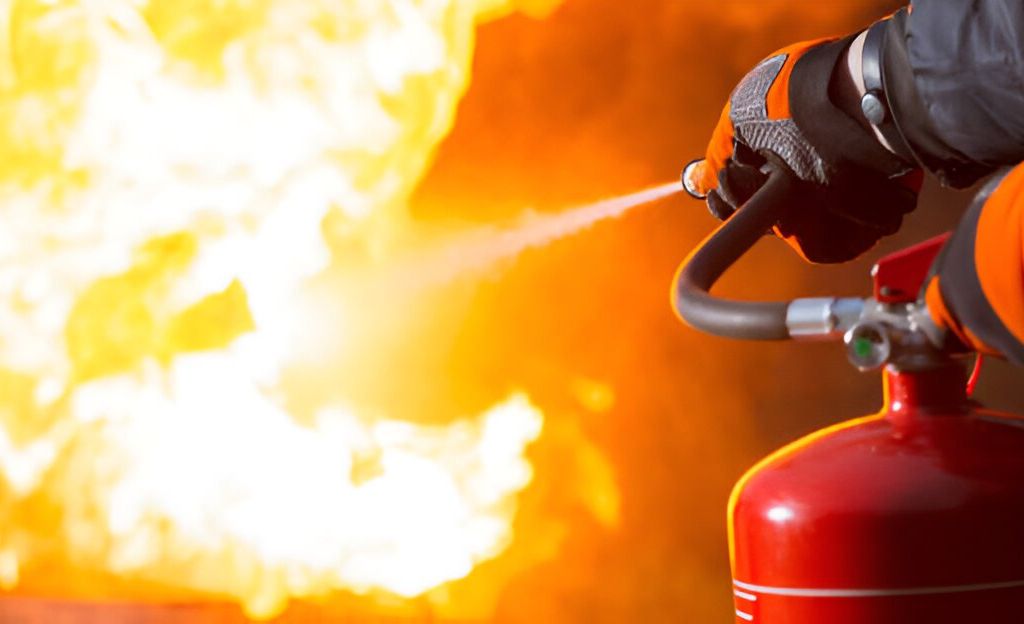
Knowledge and implementation of fire safety protocols are fundamental. This encompasses recognizing common fire risks, understanding the suitable responses to fire outbreaks, and maintaining regular safety checks. For instance, knowing how to handle and store flammable materials correctly can significantly mitigate the risk of accidental fires.
Moreover, staying updated with the latest fire safety standards and technologies plays a crucial role. It involves regular training and drills that reinforce safe practices and prepare individuals for emergency situations.
Whether it’s a complex corporate environment or a simple household setup, the integration of these safety measures promotes a culture of safety and readiness that transcends the basic knowledge of fire risks, positioning safety as a continuous priority.
Purpose of Fire Safety Tips
Understanding the objectives behind fire safety tips is fundamental to appreciating their importance in both personal and professional settings. These guidelines are meticulously crafted to minimize the risk of fire-related incidents, protect property, and ensure the safety of individuals within various environments. The core purpose of fire safety tips is to foster a culture of preparedness and prevention, aiming to reduce the frequency and severity of fires.
Fire safety tips are designed to address common causes of fires, such as cooking accidents, which are among the leading contributors to home fire incidents. By educating the public on how to handle and prevent such occurrences, these tips significantly lower the chances of devastating losses and injuries. They also extend to safeguarding businesses and residential areas by emphasizing the significance of maintaining proper safety standards and equipment in buildings.
Moreover, these tips contribute to overall community safety. They encourage individuals to act proactively, not reactively, enhancing their ability to manage potential fire outbreaks effectively. This proactive approach not only saves lives but also conserves resources by preventing the enormous costs associated with fire damage restoration and insurance.
Hence, understanding and implementing fire safety tips is crucial in creating a safer, more resilient society.
Top 10 Fire Safety Tips
To ensure the highest level of safety at home and in the workplace, here are ten critical fire safety tips.
First, create a comprehensive fire escape plan and practice it regularly with all occupants to ensure everyone knows multiple exit routes.
Secondly, maintain a safe distance of flammable materials from heat sources to prevent ignition. Always store flammable liquids in approved containers and designated areas.
Thirdly, adopt safe cooking practices, never leaving cooking appliances unattended and keeping the cooking area free of combustible materials.
Fourth, ensure that electrical appliances are in good condition, avoiding the use of damaged cords and overloaded circuits. Regularly inspect and maintain heating systems to prevent malfunction and potential fires.
Familiarize yourself and others with the locations and proper use of fire extinguishers suitable for different types of fires. Additionally, establish clear rules for smoking areas and ensure proper disposal of smoking materials.
For outdoor safety, adhere strictly to local guidelines on fire pits and open flames, especially during dry conditions.
Educate all residents or employees on these safety protocols, and continuously update and communicate any changes in safety guidelines to ensure compliance and awareness.
Install Smoke Alarms
Installing smoke alarms in every level of your home or office is an essential step in fire prevention and safety. These devices are critical in the early detection of fires, offering occupants vital minutes to evacuate safely.
To maximize effectiveness, install smoke alarms in every sleeping area, outside each separate sleeping area, and on every level of the building, including basements. It’s advisable to use interconnected smoke alarms that, when one sounds, trigger all others simultaneously, ensuring all occupants are alerted regardless of their location.
Regular maintenance of smoke alarms is equally crucial. Test each unit monthly by pressing the test button, and replace batteries at least once a year or whenever an alarm chirps, signaling low power.
Never disable a smoke alarm while cooking – this is a common mistake that can have fatal consequences. Instead, opt for photoelectric alarms or those with a ‘hush’ feature to minimize false alarms.
Additionally, replace any smoke alarm that is more than 10 years old. Over time, sensors in smoke alarms degrade, reducing their efficacy and potentially failing to activate during a fire, thus compromising the safety of the building’s occupants.
Create an Escape Plan
While installing smoke alarms forms the foundation of fire safety, equally important is the development of a robust escape plan. An effective escape plan not only outlines clear exit routes from all rooms but also includes regular practice drills that ensure everyone in the household or workplace can respond swiftly and safely in the event of a fire.
Begin by sketching a floor plan of your building, marking two exits from each room, including windows and doors. Ensure that pathways to these exits remain unobstructed at all times and are well-known to all occupants. The importance of accessibility cannot be overstated, particularly for individuals with disabilities.
Next, designate a safe meeting point outside the building where everyone can assemble after escaping to ensure no one is missing. This location should be a safe distance from the building and easily accessible for all evacuees.
Conduct fire drills at least twice a year. During these drills, practice using different escape routes to familiarize everyone with all possible options. This practice helps to reduce panic and confusion during an actual emergency.
Keep Flammables Away
Storing flammable materials safely is a critical component of fire prevention. Flammable materials, such as gasoline, solvents, and aerosols, possess properties that can easily ignite under certain conditions, posing significant risks in both residential and commercial settings. To mitigate these dangers, it is essential to adhere to best practices concerning the storage and handling of these volatile substances.
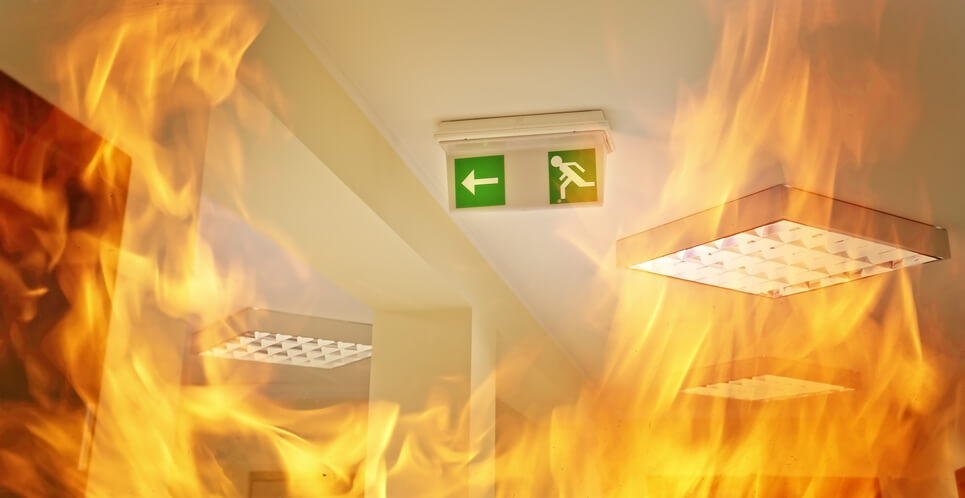
Firstly, always store flammable liquids in containers that are specifically designed for their safe storage. These containers should be constructed from non-reactive materials, tightly sealed, and clearly labeled to prevent accidental misuse.
Placement of these containers is equally critical; they should be kept in cool, well-ventilated areas away from direct sunlight and heat sources.
Furthermore, it is imperative to maintain a clean environment around storage areas. Any spills should be immediately cleaned up using appropriate methods to prevent vapors from accumulating, which could potentially create an explosive atmosphere.
Regular inspections of storage areas are also recommended to ensure compliance with safety standards and to identify any potential risks promptly.
Safe Cooking Practices
Safe cooking practices are essential for preventing kitchen fires, which are among the leading causes of home fires. To manage risks effectively, meticulous attention to the cooking environment and methods is crucial.
Firstly, never leave cooking unattended. A significant number of fires start when heat sources are left unmonitored. Whether simmering, baking, roasting, or boiling, presence is key to promptly manage any unforeseen incidents that might lead to a fire.
Secondly, maintain a clean cooking area. Grease accumulation, a common byproduct of cooking, can ignite and cause a fire if not regularly cleaned. This includes the stovetop, oven interiors, and exhaust fans. Ensuring these areas are grease-free reduces the risk of accidental fires significantly.
Additionally, it is important to keep combustible materials such as oven mitts, wooden utensils, food packaging, and towels away from the stovetop. These items can easily catch fire if they come into contact with an open flame or are exposed to heat for too long.
Lastly, investing in a Class B fire extinguisher specifically designed for kitchen use is wise. This should be readily accessible and only used after all other safety measures, like turning off heat sources and covering flames, have been implemented.
Use Electrical Appliances Safely
Numerous household fires are attributed to the improper use of electrical appliances, highlighting the critical importance of adhering to safety guidelines. Ensuring the responsible handling and maintenance of these devices is not only a preventive measure but a necessary discipline in safeguarding against electrical fires.
Proper usage of electrical appliances involves more than just following operational instructions; it extends to the care and awareness of the condition and appropriateness of electrical fixtures. Below is a detailed table that outlines key safety checks and tips for using electrical appliances securely:
| Safety Check | Action Required | Reason |
|---|---|---|
| Inspect Cords | Check for frays or cracks regularly. | Prevents electrical shorts and fire hazards. |
| Avoid Overloading | Use one appliance per outlet. | Reduces the risk of overheating and fires. |
| Proper Plugging | Insert plugs fully into sockets. | Prevents sparks that can lead to fires. |
| Unplug When Not in Use | Disconnect appliances after use. | Reduces energy consumption and fire risk. |
| Regular Maintenance | Schedule professional inspections. | Ensures appliances are in safe working order. |
Maintain Heating Systems
After addressing the safety measures for electrical appliances, it is equally important to focus on heating systems, which are fundamental components of home and workplace safety. Proper maintenance of these systems is crucial not only for efficiency but also for minimizing fire risks.
Firstly, ensure that heating systems have adequate airflow. Restricted airflow can cause overheating and potentially ignite nearby flammable materials. It’s imperative to keep furniture, curtains, and other items at least three feet away from heating units.
Secondly, regular professional inspections are essential. Certified technicians can identify and rectify issues such as faulty wiring or malfunctioning components that could lead to fires.
Furthermore, cleaning and replacing filters as recommended by the manufacturer is vital for maintaining the efficiency and safety of heating systems. Accumulated dust and debris can obstruct airflow and strain the system, increasing the risk of overheating.
Also, vents and ductwork should be cleaned to prevent dust build-ups that can catch fire from continuous heat exposure.
Lastly, always adhere to local codes and regulations regarding the installation and maintenance of heating systems. Compliance with these standards is not only a legal obligation but also a precautionary measure to ensure safety in both residential and commercial establishments.
Fire Extinguishers Usage
Understanding the correct usage and maintenance of fire extinguishers is essential for ensuring safety in both homes and workplaces. Fire extinguishers can be the first line of defense against small fires, but only if they are used correctly and kept in operational condition.
To effectively utilize fire extinguishers, it’s important to follow a structured approach to their maintenance and operation. Below is a detailed table that outlines key aspects of fire extinguisher use:
| Aspect | Detail | Importance |
|---|---|---|
| Type | Identify the correct type (A, B, C) | Matches fire scenario |
| Inspection | Monthly visual check | Ensures readiness |
| Operation | PASS technique (Pull, Aim, Squeeze, Sweep) | Effective discharge |
Firstly, identifying the right type of fire extinguisher for different kinds of fires (such as electrical, grease, or general combustibles) is crucial. Regular inspections, including checking for any signs of damage or corrosion and ensuring the gauge shows adequate pressure, are vital to maintain functionality. Lastly, everyone should be trained on the PASS technique to ensure they can operate the extinguisher effectively during an emergency. Mastery of these components enhances safety and preparedness, mitigating the risks associated with fire outbreaks.
Outdoor Fire Safety
Outdoor fire safety is an essential component of overall fire prevention, particularly in settings where open fires are common or where natural conditions may foster wildfires. Ensuring the appropriate management of outdoor fires requires adherence to specific protocols designed to mitigate risk and protect both natural environments and human settlements.
Firstly, it is crucial to establish a clear understanding of local regulations regarding fire activities. These laws often dictate permissible locations, times, and conditions under which fires may be ignited. Violations not only pose severe safety risks but can also lead to legal repercussions.
Secondly, selecting the correct site for fire activities plays a pivotal role in outdoor fire safety. Fires should be set up in contained areas, such as designated fire pits or rings that prevent the fire from spreading.
It is advisable to clear away flammable materials such as dry leaves and twigs from around the fire area to create a buffer zone, which helps in controlling unexpected fire spreads.
Furthermore, always have a method for extinguishing the fire readily available. Water sources, sand, or a commercial fire extinguisher should be within arm’s reach.
After the activity, ensure the fire is completely extinguished. Stir ashes and douse them again with water to prevent any latent embers from reigniting.
Fire Safety Education
Building on the foundation of outdoor fire safety, it is equally important to focus on educating the community about these practices. Fire Safety Education is essential in cultivating a culture of safety and preparedness that extends beyond the home and into every aspect of daily life.
Effective education strategies involve comprehensive programs that integrate the latest research, technological advancements, and practical guidelines tailored to specific environments and audiences.
Central to fire safety education is the development and dissemination of clear, accurate information regarding fire prevention, detection, suppression, and escape strategies. This information should be regularly updated and made accessible through various platforms to ensure it reaches a broad audience.
Programs should include interactive workshops, online tutorials, and community drills that engage participants and reinforce key messages.
Moreover, collaboration with fire safety professionals and local fire departments can provide invaluable real-world insights and expertise, enhancing the educational content and its practical application.
Schools, workplaces, and community centers should prioritize regular training sessions that not only teach fire safety techniques but also test these practices through simulated scenarios.
Conclusion
In conclusion, adhering to essential fire safety practices is imperative for safeguarding lives and property. By implementing measures such as installing smoke alarms, creating escape plans, and maintaining heating systems, the risks associated with fires can be significantly mitigated. Education and regular participation in community drills further ensure that individuals are prepared to respond effectively in emergency situations. Collectively, these strategies form a robust defense against the devastating impact of fires.
About the Author: LandlordCertificate
Related Posts
Get Social
Recent Posts
- Fire Risk Assessment Review as a Driver of Stronger Safety Control
- Comprehensive EICR London Services for Every Property
- System Planning for Large Buildings with Fire Alarm Installation
- Fire Service Fire Risk Assessment for Stronger Safety Management
- Electrical Risk Clarity Improved Through an EICR Report


